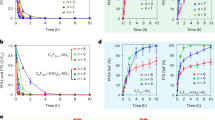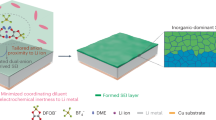Abstract
Urea is often present in waste water but can be used in powering fuel cells and as an alternative oxidation substrate to water in an electrolyser. However, an insufficient mechanistic understanding and the lack of efficient catalysts for the urea oxidation reaction have hampered the development of such applications. Here we demonstrate that a nickel ferrocyanide (Ni2Fe(CN)6) catalyst supported on Ni foam can drive the urea oxidation reaction with a higher activity and better stability than those of conventional Ni-based catalysts. Our experimental and computational data suggest a urea oxidation reaction pathway different from most other Ni-based catalysts that comprise NiOOH derivatives as the catalytically active compound. Ni2Fe(CN)6 appears to be able to directly facilitate a two-stage reaction pathway that involves an intermediate ammonia production (on the Ni site) and its decomposition to N2 (on the Fe site). Owing to the different rate-determining steps with more favourable thermal/kinetic energetics, Ni2Fe(CN)6 achieves a 100 mA cm−2 anodic current density at a potential of 1.35 V (equal to an overpotential of 0.98 V).
This is a preview of subscription content, access via your institution
Access options
Access Nature and 54 other Nature Portfolio journals
Get Nature+, our best-value online-access subscription
$29.99 / 30 days
cancel any time
Subscribe to this journal
Receive 12 digital issues and online access to articles
$119.00 per year
only $9.92 per issue
Buy this article
- Purchase on Springer Link
- Instant access to full article PDF
Prices may be subject to local taxes which are calculated during checkout





Similar content being viewed by others
Data availability
The datasets analysed and generated during the current study are included in the paper and its Supplementary Information. Source data are provided with this paper.
References
Senthilkumar, N., Gnana kumar, G. & Manthiram, A. 3D hierarchical core–shell nanostructured arrays on carbon fibers as catalysts for direct urea fuel cells. Adv. Energy Mater. 8, 1702207 (2018).
Ye, K., Wang, G., Cao, D. & Wang, G. Recent advances in the electro-oxidation of urea for direct urea fuel cell and urea electrolysis. Top. Curr. Chem. 376, 42 (2018).
Sayed, E. T. et al. Direct urea fuel cells: challenges and opportunities. J. Power Sources 417, 159–175 (2019).
Yao, S. J., Wolfson, S. K., Ahn, B. K. & Liu, C. C. Anodic oxidation of urea and an electrochemical approach to de-ureation. Nature 241, 471–472 (1973).
Wester, M. et al. Removal of urea in a wearable dialysis device: a reappraisal of electro-oxidation. Artif. Organs 38, 998–1006 (2014).
Yu, Z.-Y. et al. Ni–Mo–O nanorod-derived composite catalysts for efficient alkaline water-to-hydrogen conversion via urea electrolysis. Energ. Environ. Sci. 11, 1890–1897 (2018).
Zhang, J.-Y. et al. Energy-saving hydrogen production coupling urea oxidation over a bifunctional nickel–molybdenum nanotube array. Nano Energy 60, 894–902 (2019).
Song, J. et al. A review on fundamentals for designing oxygen evolution electrocatalysts. Chem. Soc. Rev. 49, 2196–2214 (2020).
Yu, L. et al. Non-noble metal–nitride based electrocatalysts for high-performance alkaline seawater electrolysis. Nat. Commun. 10, 5106 (2019).
Zhang, L. et al. A lattice-oxygen-involved reaction pathway to boost urea oxidation. Angew. Chem. Int. Ed. 58, 16820–16825 (2019).
Chen, S., Duan, J., Vasileff, A. & Qiao, S. Z. Size fractionation of two-dimensional sub-nanometer thin manganese dioxide crystals towards superior urea electrocatalytic conversion. Angew. Chem. Int. Ed. 55, 3804–3808 (2016).
Zhu, X. et al. Metallic nickel hydroxide nanosheets give superior electrocatalytic oxidation of urea for fuel cells. Angew. Chem. Int. Ed. 55, 12465–12469 (2016).
Zhu, B. J., Liang, Z. B. & Zou, R. Q. Designing advanced catalysts for energy conversion based on urea oxidation reaction. Small 16, 1906133 (2020).
Ding, Y. et al. Atomically thick Ni(OH)2 nanomeshes for urea electrooxidation. Nanoscale 11, 1058–1064 (2019).
Wu, F. C. et al. Bifunctional nickel oxide-based nanosheets for highly efficient overall urea splitting. Chem. Commun. 55, 6555–6558 (2019).
Daramola, D. A., Singh, D. & Botte, G. G. Dissociation rates of urea in the presence of NiOOH catalyst: a DFT analysis. J. Phys. Chem. A 114, 11513–11521 (2010).
Xie, J. et al. Copper-incorporated hierarchical wire-on-sheet α-Ni(OH)2 nanoarrays as robust trifunctional catalysts for synergistic hydrogen generation and urea oxidation. J. Mater. Chem. A 7, 13577–13584 (2019).
Forslund, R. P., Alexander, C. T., Abakumov, A. M., Johnston, K. P. & Stevenson, K. J. Enhanced electrocatalytic activities by substitutional tuning of nickel-based Ruddlesden–Popper catalysts for the oxidation of urea and small alcohols. ACS Catal. 9, 2664–2673 (2019).
Man, I. C. et al. Universality in oxygen evolution electrocatalysis on oxide surfaces. ChemCatChem 3, 1159–1165 (2011).
Seh, Z. W. et al. Combining theory and experiment in electrocatalysis: insights into materials design. Science 355, eaad4998 (2017).
Jiao, Y., Zheng, Y., Chen, P., Jaroniec, M. & Qiao, S. Z. Molecular scaffolding strategy with synergistic active centers to facilitate electrocatalytic CO2 reduction to hydrocarbon/alcohol. J. Am. Chem. Soc. 139, 18093–18100 (2017).
Simonov, A. et al. Hidden diversity of vacancy networks in Prussian blue analogues. Nature 578, 257–260 (2020).
Wang, X. W. & Cheng, L. Multifunctional Prussian blue-based nanomaterials: preparation, modification, and theranostic applications. Coord. Chem. Rev. 419, 213393 (2020).
Steen, W. A., Jeerage, K. M. & Schwartz, D. T. Raman spectroscopy of redox activity in cathodically electrodeposited nickel hexacyanoferrate thin films. Appl. Spectrosc. 56, 1021–1029 (2002).
Zhu, D. et al. Two-dimensional metal–organic frameworks with high oxidation states for efficient electrocatalytic urea oxidation. Chem. Commun. 53, 10906–10909 (2017).
Liu, D. et al. High-performance urea electrolysis towards less energy-intensive electrochemical hydrogen production using a bifunctional catalyst electrode. J. Mater. Chem. A 5, 3208–3213 (2017).
Hu, S. et al. Ni3N/NF as bifunctional catalysts for both hydrogen generation and urea decomposition. ACS Appl. Mater. Inter. 11, 13168–13175 (2019).
Sha, L. et al. The construction of self-supported thorny leaf-like nickel–cobalt bimetal phosphides as efficient bifunctional electrocatalysts for urea electrolysis. J. Mater. Chem. A 7, 9078–9085 (2019).
Yan, L. et al. Facile in-situ growth of Ni2P/Fe2P nanohybrids on Ni foam for highly efficient urea electrolysis. J. Colloid Interf. Sci. 541, 279–286 (2019).
Li, Y. J., Wang, H. W., Wang, R., He, B. B. & Gong, Y. S. 3D self-supported Fe–O–P film on nickel foam as a highly active bifunctional electrocatalyst for urea-assisted overall water splitting. Mater. Res. Bull. 100, 72–75 (2018).
Liu, Q. et al. A porous Ni3N nanosheet array as a high-performance non-noble-metal catalyst for urea-assisted electrochemical hydrogen production. Inorg. Chem. Front. 4, 1120–1124 (2017).
Xiao, C. L., Li, S. N., Zhang, X. Y. & MacFarlane, D. R. MnO2/MnCo2O4/Ni heterostructure with quadruple hierarchy: a bifunctional electrode architecture for overall urea oxidation. J. Mater. Chem. A 5, 7825–7832 (2017).
Wu, M. S., Sie, Y. J. & Yang, S. B. Hollow mesoporous nickel dendrites grown on porous nickel foam for electrochemical oxidation of urea. Electrochim. Acta 304, 131–137 (2019).
Zequine, C. et al. Nanosheets of CuCo2O4 as a high-performance electrocatalyst in urea oxidation. Appl. Sci. 9, 793 (2019).
Hu, M., Ishihara, S., Ariga, K., Imura, M. & Yamauchi, Y. Kinetically controlled crystallization for synthesis of monodispersed coordination polymer nanocubes and their self-assembly to periodic arrangements. Chem. Eur. J. 19, 1882–1885 (2013).
Zhang, W. et al. Prussian blue nanoparticles as multienzyme mimetics and reactive oxygen species scavengers. J. Am. Chem. Soc. 138, 5860–5865 (2016).
Yang, H., Wang, C., Zhang, Y. & Wang, Q. Green synthesis of NiFe LDH/Ni foam at room temperature for highly efficient electrocatalytic oxygen evolution reaction. Sci. China Mater. 62, 681–689 (2018).
Vedharathinam, V. & Botte, G. G. Understanding the electro-catalytic oxidation mechanism of urea on nickel electrodes in alkaline medium. Electrochim. Acta 81, 292–300 (2012).
Vedharathinam, V. & Botte, G. G. Direct evidence of the mechanism for the electro-oxidation of urea on Ni(OH)2 catalyst in alkaline medium. Electrochim. Acta 108, 660–665 (2013).
Vedharathinam, V. & Botte, G. G. Experimental investigation of potential oscillations during the electrocatalytic oxidation of urea on Ni catalyst in alkaline medium. J. Phys. Chem. C 118, 21806–21812 (2014).
Tang, C. et al. Se-Ni(OH)2-shelled vertically oriented NiSe nanowires as a superior electrocatalyst toward urea oxidation reaction of fuel cells. Electrochim. Acta 248, 243–249 (2017).
Garcia-Clavel, M. E., Martinez-Lope, M. J. & Casais-Alvarez, M. T. Thermal study of NiC2O4·2H2O obtained by a solid state reaction at room temperature and normal pressure. Thermochim. Acta 118, 123–134 (1987).
Chen, S. et al. Electrocatalytic synthesis of ammonia at room temperature and atmospheric pressure from water and nitrogen on a carbon-nanotube-based electrocatalyst. Angew. Chem. Int. Ed. 56, 2699–2703 (2017).
Pardue, H. L. & Mcnulty, P. J. Kinetic response of an ammonia-selective electrode evaluated for quantitation of ammonia. Anal. Chem. 60, 1351–1354 (1988).
Wen, Y. Z., Mao, Y. F., Kang, Z. F. & Luo, Q. H. Application of an ammonium ion-selective electrode for the real-time measurement of ammonia nitrogen based on pH and temperature compensation. Measurement 137, 98–101 (2019).
Nakamoto, K. Infrared and Raman Spectra of Inorganic and Coordination Compounds (John Wiley & Sons Ltd, 2006).
Griffiths, P., De Haseth, J. & Winefordner, J. Fourier Transform Infrared Spectrometry (John Wiley & Sons, Ltd, 1986).
Wang, Y. L. et al. One minute from pristine carbon to an electrocatalyst for hydrogen peroxide production. J. Mater. Chem. A 7, 21329–21337 (2019).
Lu, Z. et al. High-efficiency oxygen reduction to hydrogen peroxide catalysed by oxidized carbon materials. Nat. Catal. 1, 156–162 (2018).
Cheng, W. et al. Lattice-strained metal–organic-framework arrays for bifunctional oxygen electrocatalysis. Nat. Energy 4, 115–122 (2019).
Delley, B. An all-electron numerical method for solving the local density functional for polyatomic molecules. J. Chem. Phys. 92, 508–517 (1990).
Delley, B. From molecules to solids with the DMol3 approach. J. Chem. Phys. 113, 7756–7764 (2000).
Perdew, J. P. & Wang, Y. Accurate and simple analytic representation of the electron–gas correlation energy. Phys. Rev. B 45, 13244–13249 (1992).
Tkatchenko, A. & Scheffler, M. Accurate molecular van der Waals interactions from ground-state electron density and free-atom reference data. Phys. Rev. Lett. 102, 073005 (2009).
Allis, D. G., Prokhorova, D. A. & Korter, T. M. Solid-state modeling of the terahertz spectrum of the high explosive HMX. J. Phys. Chem. A 110, 1951–1959 (2006).
Acknowledgements
P.C. acknowledges funding from the National Natural Science Foundation of China (21771002). Q.-H.L. acknowledges funding from the National Natural Science Foundation of China (U1932212). S.-Q.L. acknowledges funding from the Key Project of Educational Department of Anhui Province (KJ2019A0861). Y.Z. acknowledges funding from the Australian Research Council (DP190103472). S.-Z.Q. acknowledges funding from the Australian Research Council (DP160104866 and FL170100154).
Author information
Authors and Affiliations
Contributions
P.C. and Y.Z. conceived the project. S.-Z.Q. supervised the project. S.-K.G. performed the material preparations, characterizations and activity tests, with the assistance of J.H. and H.-B.S. H.S., X.Z. and Q.-H.L. performed the in situ XAFS and in situ SR-FTIR tests. S.-Q.L. performed the DFT calculations. P.C., Y.Z. and S.-Z.Q. wrote the manuscript. S.-Z.Q. and M.J. revised the manuscript and discussed the draft submissions.
Corresponding authors
Ethics declarations
Competing interests
The authors declare no competing interests.
Additional information
Peer review information Nature Energy thanks Michael Busch, Xinliang Feng and Xuping Sun for their contribution to the peer review of this work.
Publisher’s note Springer Nature remains neutral with regard to jurisdictional claims in published maps and institutional affiliations.
Supplementary information
Supplementary Information
Supplementary Figs. 1–28, Tables 1 and 2, Notes 1–4 and references.
Supplementary Data 1
Energies of Ni2Fe(CN)6 (011) surface, intermediates and transition states.
Rights and permissions
About this article
Cite this article
Geng, SK., Zheng, Y., Li, SQ. et al. Nickel ferrocyanide as a high-performance urea oxidation electrocatalyst. Nat Energy 6, 904–912 (2021). https://doi.org/10.1038/s41560-021-00899-2
Received:
Accepted:
Published:
Issue Date:
DOI: https://doi.org/10.1038/s41560-021-00899-2
This article is cited by
-
Charging modulation of the pyridine nitrogen of covalent organic frameworks for promoting oxygen reduction reaction
Nature Communications (2024)
-
Nickel-iron in the second coordination shell boost single-atomic-site iridium catalysts for high-performance urea electrooxidation
Nano Research (2024)
-
Boosting urea electrooxidation on oxyanion-engineered nickel sites via inhibited water oxidation
Nature Communications (2023)
-
Relationship between oxide identity and electrocatalytic activity of platinum for ethanol electrooxidation in perchlorate acidic solution
Communications Chemistry (2023)
-
Nonredox trivalent nickel catalyzing nucleophilic electrooxidation of organics
Nature Communications (2023)



